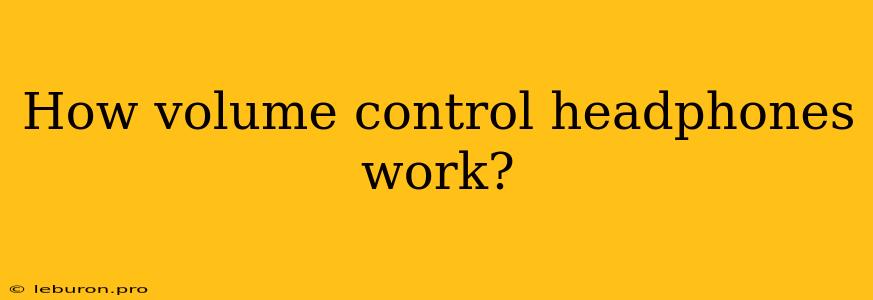The Inner Workings of Volume Control in Headphones: A Guide to Amplification and Sound Adjustment
Headphones have become ubiquitous in our daily lives, providing a personal and immersive listening experience. One of the key features that makes headphones so versatile is their ability to control volume, allowing us to tailor the sound output to our preferences and environment. But how exactly do these volume controls work within the intricate circuitry of our headphones? This article delves into the mechanisms behind volume control in headphones, explaining the role of amplification, signal manipulation, and the interplay of electronic components.
Understanding the Basics: Audio Signals and Amplification
Before exploring the intricacies of volume control, it's crucial to grasp the fundamental concept of audio signals and how they are amplified. Audio signals, essentially electrical representations of sound waves, travel through various components within a headphone system. These signals can be weak and require amplification to be audible. Amplification involves increasing the strength of these signals, making them loud enough to be perceived by our ears.
Analog vs. Digital Volume Control
Volume control in headphones can be implemented using analog or digital methods. Analog volume control typically involves adjusting the voltage level of the audio signal, while digital volume control utilizes a process known as digital signal processing (DSP) to manipulate the signal's amplitude.
Analog Volume Control: Resistors and Potentiometers
Traditional analog volume control relies on the use of resistors and potentiometers.
Resistors
Resistors are passive components that limit the flow of electrical current. In the context of volume control, they act as variable "gates" to control the amount of audio signal passing through.
Potentiometers
A potentiometer, often referred to as a "volume knob," is a variable resistor with a sliding contact. Rotating the knob alters the resistance, effectively controlling the amount of signal reaching the headphone driver. This mechanism allows us to adjust the volume in a smooth, continuous manner.
Analog Volume Control Explained
When the potentiometer's resistance is low, a greater amount of audio signal flows through, resulting in a higher volume. Conversely, when the resistance is high, less signal passes through, leading to a lower volume.
Digital Volume Control: The Power of DSP
Digital volume control takes a different approach, leveraging the capabilities of digital signal processing (DSP).
Digital Signal Processing
DSP involves manipulating digital audio signals using algorithms and specialized processors. This allows for more precise and flexible control over volume, as well as other audio enhancements like equalization and noise reduction.
Digital Volume Control Explained
Digital volume control typically involves scaling the amplitude of the audio signal. This process multiplies the signal values by a specific factor, effectively increasing or decreasing the volume. The scaling factor is determined by the user's volume setting, providing a more nuanced and granular control than traditional analog methods.
The Importance of Headphones with Built-in Amplifiers
Many modern headphones, especially those designed for high-fidelity audio, incorporate built-in amplifiers. These amplifiers are crucial for providing sufficient power to drive the headphones' drivers, ensuring optimal performance and sound quality. The volume control within these headphones often operates at the amplifier stage, allowing for precise adjustments and greater control over the signal's strength.
Amplifiers and Audio Fidelity
Amplifiers play a crucial role in delivering a clear and dynamic audio experience. They ensure that the audio signal is strong enough to accurately reproduce the intended sound without distortion.
Headphone Impedance and Amplifier Power
The impedance of headphones, a measure of their resistance to electrical current, influences the amount of power required from the amplifier. Headphones with higher impedance require more power to drive effectively, necessitating amplifiers capable of delivering sufficient output.
Exploring Different Volume Control Implementations
While the principles outlined above provide a general understanding of volume control in headphones, specific implementations can vary widely. Here are some notable variations:
Physical Volume Knobs
Traditional headphones often feature physical knobs for volume control. These knobs are directly connected to a potentiometer, providing a tactile and familiar way to adjust the volume.
Inline Volume Controls
Many wired headphones incorporate inline remote controls with volume buttons. These controls utilize push-button switches that adjust the volume by sending specific signals to the headphones' internal circuitry.
Digital Volume Control with Software
Headphones connected to a digital device, such as a smartphone or computer, often leverage software-based volume control. This allows the user to adjust the volume using a dedicated app or system settings, offering a more convenient and integrated experience.
Considerations for Choosing Headphones with Optimal Volume Control
When choosing headphones, several factors related to volume control should be taken into account:
Volume Range and Sensitivity
The volume range and sensitivity of headphones determine how loud they can get and how responsive they are to volume changes. Choose headphones with a volume range suitable for your listening preferences and a sensitivity level that allows for precise volume adjustment.
Digital vs. Analog Volume Control
Digital volume control often offers more precision and control over the audio signal, but can sometimes introduce a slight latency or processing artifact. Analog volume control can be more straightforward but may lack the same level of finesse.
Built-in Amplifier Power
If you're seeking high-fidelity audio, consider headphones with a powerful built-in amplifier capable of driving the drivers effectively.
Volume Control Location and Interface
Choose headphones with volume controls that are easily accessible and intuitive to use. Consider the location and interface of the controls in relation to your personal preferences.
Conclusion
Understanding how volume control works in headphones provides insight into the intricate mechanics that shape our listening experience. Whether it's through the traditional analog methods of resistors and potentiometers or the advanced digital signal processing capabilities of modern headphones, the ability to adjust volume allows us to personalize our audio enjoyment. By carefully considering the features and functionality of different headphones, you can select a pair that delivers the optimal volume control and audio quality to meet your needs and listening preferences.
